

|
Back to |
| The Front Page |
| News & Features |

|
Pasadena Croquet Club hosts an elite "eight" on granite-hard court |
|
by Rhys Thomas layout by Reuben Edwards Posted July 9, 2014
|
The Kiwis advanced the standard of elite croquet at the 2014 MacRob in Christchurch with a combination of (mostly) hard and very fast courts, tightly set and adjustable Atkins Quadway hoops of a radically new design, and event management just as tight as the hoops. The event made such an impression that the English croquet association embarked on a study of the question, "What makes a hoop difficult to run?" and came up with interesting answers which may lead to the production of an "elite" hoop by next year. The usual Selection Eights for the US International team—now extended to at least half a dozen "eights"--always takes place at the National Croquet Center in West Palm Beach, on sand-based courts, which are now standard in the US.
At the recent USCA Association Croquet National Championships, much courtside discussion focused on the playing conditions at the just-completed MacRobertson Shield held in New Zealand. In particular, USA team members noted how hard it was to run the novel Atkins Quadway hoops set in hard ground on lawns that were sometimes covered with actual green grass, sometimes not. The word "challenging" seemed to be universal among our lads.
So how can USA players prepare for such conditions in the future when almost every championship lawn in America is perfectly flat, beautifully green and usually sand-based? Longtime national team member and Mac veteran Jim Bast asked me that question and I had an answer for him: "Come to Pasadena."
The Pasadena Croquet Club plays on two lawns that were installed in 1921. The grass is resilient Bermuda and the base is, well, it might as well be granite for all I know. What’s certain is that we have the hardest croquet ground in all the USA and, perhaps, the world, excepting the top of Half Dome. To compound that boast, I told Jim we could sink our hoops into that granite base and create some distinctly challenging croquet conditions rivaling any club in New Zealand or Yosemite.
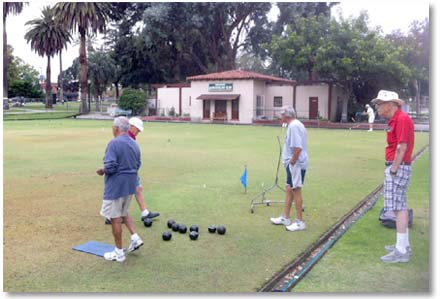
|
| The South Lawn of the Pasadena club, adjacent to the Lawn Bowlers Clubhouse, was the locale of the entire "eights" tournament, double-banked. The bowlers were having a friendly game when Rhys took the photo; the croquet tournament occupied the remainder of the lawn. |
Jim then asked if the PCC would be willing to host a small, high-level tournament designed as a training ground for USA team members and aspirants? I checked with club leader Eric Sawyer and we both thought it possible. We generally hold our club championship in June. Why not up the stakes?
Jim made some calls to USA team members around the country and got some support. He said this could happen. And so the Pasadena Croquet Invitational was conceived on the fly and recruiting began.
Pasadena club member Charlie Fleming, a talented up-and-comer who will soon ruin his promising croquet career by attending med school, convinced two of his St. John’s college buddies to come out: Charlie "Gilmo" Gillmarten and Robert Hurst, both recent USA team members. Eric recruited Martyn Selman and managed to clear his own busy docket.
Leo Nikora, recent USA team member and reigning PCC champion, naturally wanted to defend his title. Jim was in because it was his idea; and rounding out the field was USA’s number one player, Ben Rothman. With this group we had what I thought would be a very competitive "Pasadena Eight." Worth noting, half the players in the field were age 30 or under (Ben, both Charlies, and Robert).
I volunteered to be the tournament manager and reserve player in case anyone had to drop out. Thank goodness that didn’t happen.
My goal from the beginning was to oblige Jim’s vision with challenging conditions and present a world class format. I decided on a block of eight, all play all in three-hour games for the first two days, feeding into two knock-out ladders, upper and lower, with best-of-three games to the peg and no time limit to decide the champion and create a test match environment. Everyone would play two matches on the final two days.
Now, all I had to do was back up my sadistic boast about creating those challenging conditions. The ground was the ground—nothing I needed to do about that. But I could do something with the hoops. I wanted to channel the living spirit of CB Smith (now 91 and still enjoying his personal slice of Heaven in Santa Monica), who used to set hoops for the Sonoma-Cutrer World Croquet Championships. CB is a master hoop-setter, which left me thinking, "What would CB do?" Well, he’d set some scary tight hoops in that hard ground and cackle at every stuff and clang.
We used full carrot Jaques of London cast iron hoops. Each took about a hundred whacks with a three pound sledge to get them into the granite-like base. I told the players this would be only time we caught fresh ground—there just wasn’t a chance of whacking them in more than once, and I was confident that the hoops would hold their settings for all four days. Using a Rodoni hoop clamp (my favorite hoop-setting contraption), I set the clearance for the first day’s play at slightly under 1/16th. Ease the guys in, I thought. I’d set the hoops tighter each day until I reached 1/64th on the final day. They sunk in as expected and might as well have been set in concrete.
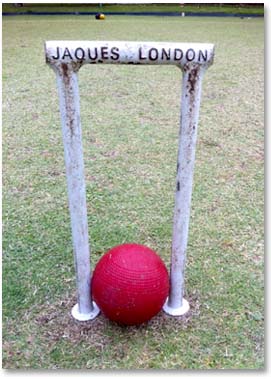
|
| Can you see daylight? |
By the end of Day One, America’s number one player was in fourth place, on the cusp of making the championship cut. That got Ben’s attention.
Over the next four days, the hoops punished bullies, rewarded precision, and took no prisoners. Add in the beguiling Bermuda lawns with patches of green and brown and every shot was a treacherous journey. Jim said it was "decidedly Antipodean," unlike any other venue in the US. In my mind’s ear I heard CB cackle with delight.
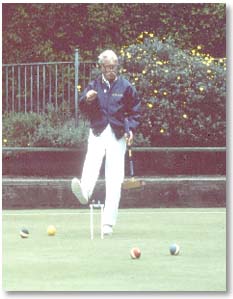
|
| C.B. Smith at the San Francisco Open in 1995. |
Playing to form, Ben and Jim advanced to the final, knocking Robert and Leo into the 3rd place match. Martyn and Eric reached the final in the consolation ladder.
The hoops set up as planned for the final day, with nary a slice of light visible between ball and uprights. During the first hour of play, Ben, Leo, Jim and Robert, double-banking on the South Lawn, made a cumulative total of five hoops. Leo wondered if they would finish a single game before dark, let alone a full match.
Those fears vanished as Ben adapted his play to the conditions and ran two remarkably controlled triple-peels to win the championship. Robert took third with some excellent play of his own.
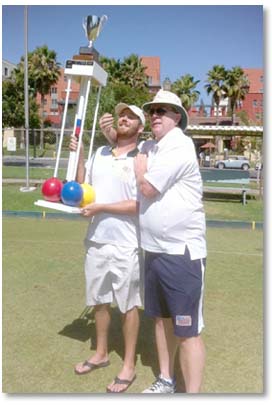
|
| Ben Rothman and Jim Bast. |
Of note, Jim played the entire final with an ailing shoulder, the result of an injury during his semi-final match. At one point he thought about withdrawing, but knew if he did that he’d hear from Doug Grimsley, who played for five days at the recent World Croquet Federation World Championships on a broken leg.
To round out the tournament, the Pasadena Lawn Bowling Club graciously opened its clubhouse to the croquet players, providing a welcome respite from the sun and a place to eat. In a throwback to the old days of croquet, a modest continental breakfast and deli buffet lunch was provided to the players each day, compliments of Michelle Thomas. PCC member Joanne Woods baked a delicious Apple Crisp. And in a nod to the overseas tradition of the croquet pub, players enjoyed a few cold ones after play each day. Well, maybe more than a few.
The tournament could not have happened without the support and help of Caren and Eric Sawyer, who continue to be the guiding lights of the Pasadena Croquet Club. All in all, a great debut for the Pasadena Eight.
Final Standings in the Pasadena Eight
1. Ben Rothman
2. Jim Bast
3. Robert Hurst
4. Leo Nikora
5. Martyn Selman
6. Eric Sawyer
7. Charlie Gillmarten
8. Charlie Fleming
CA Hoop Tests 2014 - Supplement
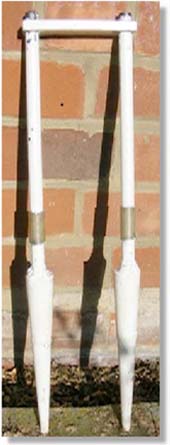
|
The full report of the April tests is available at https://www.croquet.org.uk/?p=tech/equipment/hoopTests2014.html
During the April tests, we established that hoops with square parsnips or longer cylindrical carrots both made hoops more challenging, as did (in some cases) more massive superstructures. But the biggest effect was shown when the uprights were less slippery - gripping the ball to some extent.
These factors seemed to make the Atkins Quadway and Egyptian Golf Croquet hoop both about 5 degrees more difficult to run than typical hoops - the critical angle was reduced from around 45 to around 40 degrees.
But two experimental hoops - using knurled uprights or rubber-covered uprights - were even more effective, and reduced the critical angle to around 30 degrees. Both had wear problems: the knurled uprights took plastic swarf off the balls on contact, and the rubber covering wore through after around 60 strokes.
So the CA Equipment Committee decided to explore this effect further, and seek a material that didn't pose a threat to the balls and which would also have a long life. An obvious choice was polyurethane (PU) - which is the core ingredient of Dawson balls. Dave Trimmer produced for the Equipment Committee a test hoop with PU coverings (about 2mm thick) to the uprights. The test hoop only has the PU at around half-ball height - any production hoop would need the PU to extend right up the uprights.
This was tried informally/ subjectively at the InterCounty Championships, where perhaps 30 people tried it themselves. As reported below, a supplementary objective test was undertaken using the same rig as the earlier tests.
The top 15cm of soil was damper than during the April 2014 tests, so the results should not be precisely compared to the previous tests.
Results
The new test hoop - Hoop 9 - was compared to our standard reference hoop (#1) - the production Aldridge hoop.
Critical Angle
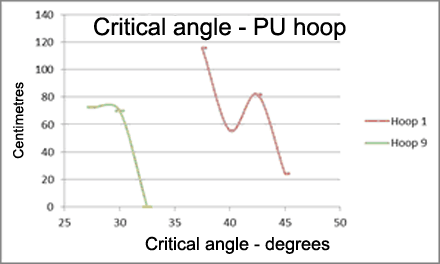
|
As previously found, the critical angle of Hoop 1 - a typical hoop - was around 45 degrees.
But Hoop 9 with the PU uprights had a much narrower critical angle - 32.5 degrees. Extreme angled shots also resisted "bullying" to a good degree.
This is a much more significant reduction that found with any other production hoops, including Atkins or Egyptian Golf Croquet hoops.
Tolerance to Poor Hoop Strokes
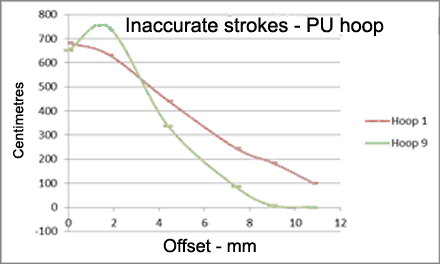
|
Similarly, while an accurate hoop stroke ran through much the same as with our reference hoop, once the stroke was 4 or more millimetres off-centre, the "runnability" quickly fell away. Hoop 9 was much more resistant to poor straight strokes.
Subjective Test Comments
Comments from those who tried Hoop 9 at the InterCounties showed:
* the hoop was significantly harder to run unless hit at precisely the right aiming point
* the critical angle was reduced, and extremely angled hoops were unlikely to be run
* gentle shots got a very rubbery rejection - while harder strokes were more often tolerated
* there was general support for this being a direction worth exploration - although one lamented it might make all championship hoop strokes firm ones, losing the subtlety.
Conclusions
This supplementary test has confirmed that "grippiness" is a significant factor in producing an elite AC hoop.
Polyurethane is an appropriate material. There was no sign of wear on either the PU uprights or balls after the tests.
It is probable that the 2mm thick coating of this particular soft grade of PU was too "squishy". This gave rise to the rubbery rejections on gentle strokes, and the greater depth that could squash probably contributed to allowing harder strokes to run more easily than gentle ones.
Next Steps
We need to home in on a firmer grade of PU and clarify how best we could cover the whole of the uprights with it. There are several possibilities: tubing, mouldings, PU spray coating, etc. Having found an ideal grade of PU (or some similar plastic) and worked out how to coat the entire uprights, we should then:
1. repeat the tests with a test hoop to confirm the performance
2. request Council supports the production of a set of six for field trials.
© 2014 The Croquet Association - www.croquet.org.uk